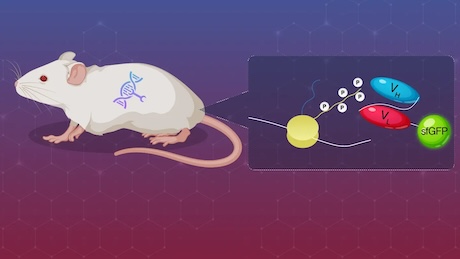Life Science and Technology News
Novel Customizable Immunoassay May Revolutionize Diagnostics and On-Site Assessments!
Researchers designed a system to detect target analytes with exceptional sensitivity in a fast, simple, and convenient way
A novel customizable OpenGUS immunoassay that detects analytes quickly and effectively has been developed by scientists from Science Tokyo. With specially designed β-glucuronidase (GUS) probes and optimized reaction conditions, this platform provides a hassle-free yet extremely sensitive approach for detecting relevant biomarkers, allergens, or other biomolecules. This makes homogenous immunoassays more widely available for point-of-care diagnostics, high-throughput testing, environmental monitoring, and food safety analysis, even when sophisticated laboratories are unavailable.
A Convenient and Sensitive Immunoassay Platform for Homogenous Detection of Analytes

Customizable OpenGUS Immunoassay: A Homogeneous Detection System
Using β-glucuronidase Switch and Label-free Antibody
Zhu et al. (2024) | Biosensors and Bioelectronics | 10.1016/j.bios.2024.116796
Immunoassays have become an essential tool in analytical chemistry over the past few decades. This biochemical technique leverages the natural ability of antibodies to bind to specific targets, enabling the detection and quantification of desired analytes. Though immunoassays are directly responsible for many scientific discoveries in biology and medicine and have long-standing advantages in clinical diagnosis, they have their disadvantages.
Heterogeneous immunoassays require the physical separation of components bound to the antibodies from those that remain unbound. Such methods are robust and reliable, but they involve intricate and lengthy procedures to get results, which requires highly skilled laboratory personnel. On the other hand, homogenous immunoassays do not require separation, since bound antibodies are designed to emit a detectable signal via luminescence or fluorescence. While quicker and more convenient than heterogeneous immunoassays, these techniques involve complex antibody genetic engineering or modification procedures and are also more susceptible to background noise.
To fill this gap, researchers from Institute of Science Tokyo (Science Tokyo), Japan, developed a new type of customizable homogeneous immunoassay. The research team led by Associate Professor Tetsuya Kitaguchi proposed an approach that offers a convenient, versatile, and highly effective strategy to detect various target analytes. The findings of this study were made available online on 18 September 2024 and published on 1 January 2025 in the journal Biosensors and Bioelectronics![]() .
.
The main elements of this new immunoassay platform are the OpenGUS probes. These probes are artificial proteins made of two Z-domains and a spacer, designed to pinch and strongly bind to one end of the antibodies, and a β-glucuronidase (GUS) monomer. The antibodies get docked in between the Z-domains and, when they bind to their target antigens, the GUS monomers in the probes are brought closer together. This causes the formation of GUS tetramer, an active enzyme capable of cleaving glucuronide substrates, which is the underlying principle for detection. When specially designed glucuronide molecules are cleaved, the resulting products emit a detectable fluorescent signal or cause the color of the solution to visibly change.
A simple combination of antibodies, OpenGUS probes, and specific substrates can detect nanomolar or even picomolar concentrations of analytes. The researchers achieved this feat by introducing strategic mutations in the GUS monomers to reduce the spontaneous activation, as well as by optimizing the composition of the reaction buffer used. "Thanks to our optimization procedure, the immunoassay results can be confirmed using a smartphone or the naked eye in situations where a fluorometer is unavailable, such as outdoors, at home, or in less-equipped laboratories," remarks Kitaguchi.
The researchers validated their method by detecting three representative analytes: a Japanese cedar pollen allergen, a human protein biomarker for cardiovascular disease, and human lactoferrin, a biomarker for inflammation. Unlike other immunoassay techniques, long pre-incubation periods at low temperatures and complex genetic modification of antibodies was not required. These advantages suggest that the proposed strategy could become the mainstay for both research and practical settings. "We believe that our customizable OpenGUS immunoassay will pave the way for the prompt development of rapid and sensitive homogenous immunoassay platforms for point-of-care diagnostics, high-throughput testing, and onsite environmental assessments," concludes Kitaguchi, highlighting the impact of their study.
- Reference
| Authors: |
Bo Zhu1, Yukihiko Yamasaki2, Takanobu Yasuda1, Cheng Qian3, Zhirou Qiu3, Mitsue Nagamine4, Hiroshi Ueda1, and Tetsuya Kitaguchi1* *Corresponding author(s) |
|---|---|
| Title: | Customizable OpenGUS immunoassay: A homogeneous detection system using β-glucuronidase switch and label-free antibody |
| Journal: | Biosensors and Bioelectronics |
| Affiliations: |
1 Laboratory for Chemistry and Life Science, Institute of Innovative Research, Tokyo Institute of Technology, Japan 2 BioDynamics Laboratory Inc., Japan 3 Graduate School of Life Science and Technology, Tokyo Institute of Technology, Japan 4 Institute for Liberal Arts, Tokyo Institute of Technology, Japan |
| DOI: |
10.1016/j.bios.2024.116796 |
- A Novel High-Throughput Method for Screening Protein-Secreting Microbial Strains | Life Science and Technology News
- Quenchbody Immunosensors Pave the Way to Quick and Sensitive COVID-19 Diagnostics | Life Science and Technology News
- Shedding New Light: A New Type of Immunosensor for Immunoassay Tests | Life Science and Technology News
- Live cell imaging: 'Green Glifons' for real-time monitoring of glucose metabolism | Life Science and Technology News
- Uncovering the Link Between Attending Prenatal Checkups and Low Birth Weight in Japan | Formerly Tokyo Tech
- Tetsuya Kitaguchi | Researcher Finder - Science Tokyo STAR Search
- Bo Zhu | Researcher Finder - Science Tokyo STAR Search
- Takanobu Yasuda | Researcher Finder - Science Tokyo STAR Search
- Mitsue Nagamine | Researcher Finder - Science Tokyo STAR Search
- Tetsuya Kitaguchi Laboratory
- Nagamine Laboratory
- Laboratory for Chemistry and Life Science, Institute of Integrated Research
- Institute of Integrated Research | Science Tokyo organization | About Science Tokyo
- Institute for Liberal Arts | Science Tokyo organization | About Science Tokyo
- Department of Life Science and Technology, School of Life Science and Technology
- Department of Social and Human Sciences, School of Environment and Society
Further information
Associate Professor Tetsuya Kitaguchi
School of Life Science and Technology, Institute of Science Tokyo
E-mail kitaguc.t.aa@m.titech.ac.jp





